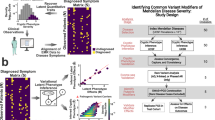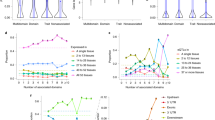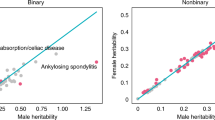Abstract
For the past century, Mendelian and multifactorial traits have existed at opposite ends of the disease spectrum in humans. Furthermore, the recent emphasis on genome-wide association studies for uncovering variants that underlie common diseases has risked deepening the divide — or has it? Four experienced human geneticists express their views on the changing landscape of human disease studies and the impact of new technologies and study designs on the age-old aim of connecting a genomic variant with its phenotypic consequences.
This is a preview of subscription content, access via your institution
Access options
Subscribe to this journal
Receive 12 print issues and online access
$189.00 per year
only $15.75 per issue
Buy this article
- Purchase on Springer Link
- Instant access to full article PDF
Prices may be subject to local taxes which are calculated during checkout

Similar content being viewed by others
References
Gibbs, J. R. & Singleton, A. Application of genome-wide single nucleotide polymorphism typing: simple association and beyond. PLoS Genet. 2, e150 (2006).
van de Leemput, J. & Chandran, J. et al. Deletion at ITPR1 underlies ataxia in mice and spinocerebellar ataxia 15 in humans. PLoS Genet. 3, e108 (2007).
Ng, S. B. et al. Targeted capture and massively parallel sequencing of 12 human exomes. Nature 461, 272–276 (2009).
Singleton, A., Myers, A. & Hardy, J. The law of mass action applied to neurodegenerative disease: a hypothesis concerning the etiology and pathogenesis of complex diseases. Hum. Mol. Genet. 13, R123–R126 (2004).
Hutton, M. et al. Association of missense and 5′-splice-site mutations in tau with the inherited dementia FTDP-17. Nature 393, 702–705 (1998).
Harold, D., Abraham, R. & Hollingworth, P. et al. Genome-wide association study identifies variants at CLU and PICALM associated with Alzheimer's disease. Nature Genet. 41, 1088–1093 (2009).
Lambert, J.-C. et al. Genome-wide association study identifies variants at CLU and CR1 associated with Alzheimer's disease. Nature Genet. 41, 1094–1099 (2009).
McGeer, E. G., Klegeris, A. & McGeer, P. L. Inflammation, the complement system and the diseases of aging. Neurobiol. Aging 26 (Suppl. 1), 94–97 (2005).
Alexander, J. J., Anderson, A. J., Barnum, S. R., Stevens, B. & Tenner, A. J. The complement cascade: Yin–Yang in neuroinflammation — neuro-protection and -degeneration. J. Neurochem. 107, 1169–1187 (2008).
Manolio, T. A. et al. Finding the missing heritability of complex diseases. Nature 461, 747–753 (2009).
Weatherall, D. J. Phenotype–genotype relationships in monogenic disease: lessons from the thalassaemias. Nature Rev. Genet. 2, 245–255 (2001).
Botstein, D., White, R. L., Skolnick, M. & Davis, R. W. Construction of a genetic linkage map in man using restriction fragment length polymorphisms. Am. J. Hum. Genet. 32, 314–331 (1980).
Gusella, J. F. et al. A polymorphic DNA marker genetically linked to Huntington's disease. Nature 306, 234–236 (1983).
Saiki, R. K. et al. Enzymatic amplification of β-globin genomic sequences and restriction site analysis for diagnosis of sickle cell anemia. Science 230, 1350–1354 (1985).
Lander, E. S. et al. Initial sequencing and analysis of the human genome. Nature 409, 860–921 (2001).
Venter, J. C. et al. The sequence of the human genome. Science 291, 1304–1351 (2001).
Waterston, R. H. et al. Initial sequencing and comparative analysis of the mouse genome. Nature 420, 520–562 (2002).
Altshuler, D. et al. A haplotype map of the human genome. Nature 437, 1299–1320 (2005).
Ng, S. B. et al. Exome sequencing identifies the cause of a Mendelian disorder. Nature Genet. 42, 30–35 (2010).
Altshuler, D., Daly, M. J. & Lander, E. S. Genetic mapping in human disease. Science 322, 881–888 (2008).
Dermitzakis, E. T., Reymond, A. & Antonarakis, S. E. Conserved non-genic sequences — an unexpected feature of mammalian genomes. Nature Rev. Genet. 6, 151–157 (2005).
Author information
Authors and Affiliations
Ethics declarations
Competing interests
John Hardy consults on Alzheimer's disease and Parkinson's disease for Eisai and MerckSerono.
Related links
Related links
DATABASES
OMIM
progressive supranuclear palsy
FURTHER INFORMATION
Stylianos E. Antonarakis's homepage
Rights and permissions
About this article
Cite this article
Antonarakis, S., Chakravarti, A., Cohen, J. et al. Mendelian disorders and multifactorial traits: the big divide or one for all?. Nat Rev Genet 11, 380–384 (2010). https://doi.org/10.1038/nrg2793
Issue Date:
DOI: https://doi.org/10.1038/nrg2793
This article is cited by
-
The role of admixture in the rare variant contribution to inflammatory bowel disease
Genome Medicine (2023)
-
Neuroinflammation represents a common theme amongst genetic and environmental risk factors for Alzheimer and Parkinson diseases
Journal of Neuroinflammation (2022)
-
Correlation scan: identifying genomic regions that affect genetic correlations applied to fertility traits
BMC Genomics (2022)
-
A genome-wide association study on photic sneeze reflex in the Chinese population
Scientific Reports (2019)
-
Discovery of mutations for Mendelian disorders
Human Genetics (2016)



